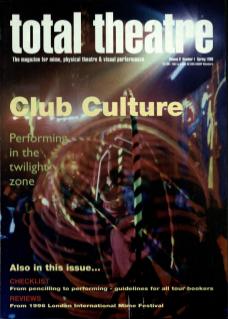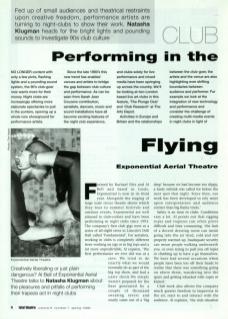'Club Culture is a self-designing system, which moves too fast for security and casts its net too wide for containment. It deals less with the speed of a perpetual present than the ecstasy of accelerating mutation. Its sites might be small and continuous, but there is nothing marginal or peripheral about its effects. – Sadie Plant, Hybrid
No longer content with only a few pints, flashing lights and a pounding sound system, the 90s club-goer now wants more for their money. Night clubs are increasingly offering more elaborate spectacles to pull in the punters, opening up a whole new showground for performance artists.
Since the late 1980s this new trend has enabled venues and artists to bridge the gap between club culture and performance. As can be seen from Sarah Jean Couzens’ contribution, aerialists, dancers, music and sound installations have all become exciting features of the night club experience, and clubs solely for live performance and mixed media have been springing up across the country. We'll be looking at two London based live art clubs in this feature, The Plunge Club and Club Research at The Arts Depot.
Activities in Europe and Britain and the relationships between the club-goer, the artists and the venue are also highlighting ever shifting boundaries between audience and performer. For example we look at the integration of new technology and performance and consider the challenge of creating multimedia events in nightclubs in light of Songs of X-perience at Subterranea. We also look at issues of gender, politics and youth culture in the context of the work of companies and performers like Exponential Aerial Theatre, John-Paul Zaccarini and Shinkansen, and in venues like London club, Heaven.
There are benefits and pitfalls for artists performing in nightclubs. They are energetic spaces with varied audiences where radical new material is being explored. However, performers can be faced with inattentive, drug and alcohol induced crowds who may not respect their artistic endeavours. But for performers whose work requires live sound and a human, buzzing environment, the club is the place to be. Only there can they find that special element of danger and excitement that will bring their work to life.


